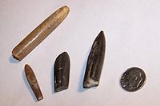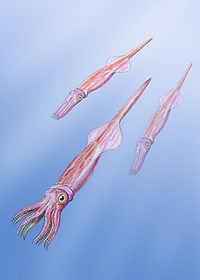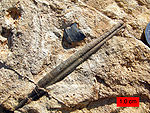
Belemnoidea
Encyclopedia

Cephalopod
A cephalopod is any member of the molluscan class Cephalopoda . These exclusively marine animals are characterized by bilateral body symmetry, a prominent head, and a set of arms or tentacles modified from the primitive molluscan foot...
, very similar in many ways to the modern squid
Squid
Squid are cephalopods of the order Teuthida, which comprises around 300 species. Like all other cephalopods, squid have a distinct head, bilateral symmetry, a mantle, and arms. Squid, like cuttlefish, have eight arms arranged in pairs and two, usually longer, tentacles...
and closely related to the modern cuttlefish
Cuttlefish
Cuttlefish are marine animals of the order Sepiida. They belong to the class Cephalopoda . Despite their name, cuttlefish are not fish but molluscs....
. Like them, the belemnoids possessed an ink sac
Ink sac
With the exception of nocturnal and very deep water cephalopods, all coeloids which dwell in light conditions have an ink sac, which can be used to expel a cloud of dark ink to confuse predators. This sac is a muscular bag which originated as an extension of the hind gut...
, but, unlike the squid, they possessed ten arms
Cephalopod arm
A cephalopod arm is distinct from a tentacle, though the terms are often used interchangeably.Generally, cephalopod arms have suckers along most of their length, as opposed to tentacles, which have suckers only near their ends. Octopuses have eight arms and no tentacles, while squid and cuttlefish...
of roughly equal length, and no tentacle
Tentacle
A tentacle or bothrium is one of usually two or more elongated flexible organs present in animals, especially invertebrates. The term may also refer to the hairs of the leaves of some insectivorous plants. Usually, tentacles are used for feeding, feeling and grasping. Anatomically, they work like...
s. The name "belemnoid" comes from the Greek word belemnon meaning "a dart or arrow" and the Greek word eidos meaning "form".
Belemnoids include belemnites (which belong to order
Order (biology)
In scientific classification used in biology, the order is# a taxonomic rank used in the classification of organisms. Other well-known ranks are life, domain, kingdom, phylum, class, family, genus, and species, with order fitting in between class and family...
Belemnitida
Belemnitida
Belemnitida is an extinct order of cephalopods which existed during the Mesozoic era, from the Hettangian age of the Lower Jurassic to the Maastrichtian age of the Upper Cretaceous.-Description:...
proper), aulacocerids (order Aulacocerida
Aulacocerida
Aulacocerida is an extinct order of belemnoids....
), phragmoteuthids (order Phragmoteuthida
Phragmoteuthida
Phragmoteuthida is an order of coleoid cephalopods.-Classification:* Order Phragmoteuthida**Family Phragmoteuthididae***Genus Permoteuthis***Genus Phragmoteuthis***"unnamed form"**Family Rhiphaeoteuthidae***Genus Rhiphaeoteuthis...
), and diplobelids (order Diplobelida).
Occurrence
Belemnoids were numerous during the JurassicJurassic
The Jurassic is a geologic period and system that extends from about Mya to Mya, that is, from the end of the Triassic to the beginning of the Cretaceous. The Jurassic constitutes the middle period of the Mesozoic era, also known as the age of reptiles. The start of the period is marked by...
and Cretaceous
Cretaceous
The Cretaceous , derived from the Latin "creta" , usually abbreviated K for its German translation Kreide , is a geologic period and system from circa to million years ago. In the geologic timescale, the Cretaceous follows the Jurassic period and is followed by the Paleogene period of the...
periods, and their fossil
Fossil
Fossils are the preserved remains or traces of animals , plants, and other organisms from the remote past...
s are abundant in Mesozoic
Mesozoic
The Mesozoic era is an interval of geological time from about 250 million years ago to about 65 million years ago. It is often referred to as the age of reptiles because reptiles, namely dinosaurs, were the dominant terrestrial and marine vertebrates of the time...
marine rocks, often accompanying their cousins the ammonite
Ammonite
Ammonite, as a zoological or paleontological term, refers to any member of the Ammonoidea an extinct subclass within the Molluscan class Cephalopoda which are more closely related to living coleoids Ammonite, as a zoological or paleontological term, refers to any member of the Ammonoidea an extinct...
s. The belemnoids become extinct at the end of the Cretaceous period along with the ammonites. The belemnoids' origin lies within the bactritoid
Bactritida
The Bactritida form a small order of more or less straight-shelled cephalopods that first appeared during the Emsian Stage of the Devonian Period and persisted until the Carnian Stage of the Triassic Period...
nautiloids, which date from the Devonian
Devonian
The Devonian is a geologic period and system of the Paleozoic Era spanning from the end of the Silurian Period, about 416.0 ± 2.8 Mya , to the beginning of the Carboniferous Period, about 359.2 ± 2.5 Mya...
period; well-formed belemnoid guards can be found in rocks dating from the Mississippian (or Early Carboniferous
Carboniferous
The Carboniferous is a geologic period and system that extends from the end of the Devonian Period, about 359.2 ± 2.5 Mya , to the beginning of the Permian Period, about 299.0 ± 0.8 Mya . The name is derived from the Latin word for coal, carbo. Carboniferous means "coal-bearing"...
) onward through the Cretaceous. Other fossil cephalopod
Cephalopod
A cephalopod is any member of the molluscan class Cephalopoda . These exclusively marine animals are characterized by bilateral body symmetry, a prominent head, and a set of arms or tentacles modified from the primitive molluscan foot...
s include baculite
Baculite
Baculites is an extinct cephalopod genus with a nearly straight shell that is included in the heteromorph ammonites...
s, nautiloid
Nautiloid
Nautiloids are a large and diverse group of marine cephalopods belonging to the subclass Nautiloidea that began in the Late Cambrian and are represented today by the living Nautilus. Nautiloids flourished during the early Paleozoic era, where they constituted the main predatory animals, and...
s and goniatite
Goniatite
Goniatites are extinct ammonoids, shelled cephalopods related to squid, octopus, and belemnites, that form the order Goniatitida. The Gonatitida originated from within the more primitive anarcestine ammonoids in the Middle Devonian some 390 million years ago...
s.
Anatomy
Belemnoids possessed a central phragmoconePhragmocone
The phragmocone is the chambered portion of the shell of a cephalopod. It is divided by septa into camerae.In most nautiloids and ammonoids, the phragmocone is a long, straight, curved, or coiled structure, in which the camarae are linked by a siphuncle which determines buoyancy by means of gas...
made of aragonite
Aragonite
Aragonite is a carbonate mineral, one of the two common, naturally occurring, crystal forms of calcium carbonate, CaCO3...
and with negative buoyancy. To the rear of the creature was a heavy calcite
Calcite
Calcite is a carbonate mineral and the most stable polymorph of calcium carbonate . The other polymorphs are the minerals aragonite and vaterite. Aragonite will change to calcite at 380-470°C, and vaterite is even less stable.-Properties:...
guard whose main role appears to have been to counterbalance the front of the organism; it positions the centre of mass below the centre of buoyancy, increasing the stability of the swimming organism. The guard would account for between a third and a fifth of the length of the complete organism, arms included.
Like some modern squid, belemnoid arms carried a series of small hooks for grabbing prey. Belemnoids were efficient carnivore
Carnivore
A carnivore meaning 'meat eater' is an organism that derives its energy and nutrient requirements from a diet consisting mainly or exclusively of animal tissue, whether through predation or scavenging...
s that caught small fish
Fish
Fish are a paraphyletic group of organisms that consist of all gill-bearing aquatic vertebrate animals that lack limbs with digits. Included in this definition are the living hagfish, lampreys, and cartilaginous and bony fish, as well as various extinct related groups...
and other marine animals with their arms and ate them with their beak-like jaws. In turn, belemnites appear to have formed part of the diet of marine reptile
Reptile
Reptiles are members of a class of air-breathing, ectothermic vertebrates which are characterized by laying shelled eggs , and having skin covered in scales and/or scutes. They are tetrapods, either having four limbs or being descended from four-limbed ancestors...
s such as Ichthyosaur
Ichthyosaur
Ichthyosaurs were giant marine reptiles that resembled fish and dolphins...
s, whose fossilized stomach
Stomach
The stomach is a muscular, hollow, dilated part of the alimentary canal which functions as an important organ of the digestive tract in some animals, including vertebrates, echinoderms, insects , and molluscs. It is involved in the second phase of digestion, following mastication .The stomach is...
s frequently contain phosphatic
Phosphate minerals
Phosphate minerals are those minerals that contain the tetrahedrally coordinated phosphate anion along with the freely substituting arsenate and vanadate...
hooks from the arms of cephalopods.
Ecology
Belemnoids were effectively neutrally buoyant, and swam in near-shore to mid-shelf oceans. Their fins could be used to their advantage in all water speeds; in a gentle current they could be flapped for propulsion; in a stronger current they could be held erect to generate lift; and when swimming rapidly by jet propulsion they could be tucked in to the body for streamlining.Preservation
Normally with fossil belemnoids only the back part of the shell (called the guard or rostrum) is found. The guard is usually elongated and bullet-shaped (though in some subgroups the rostrum may only exist as a thin layer coating the phragmocone). The hollow region at the front of the guard is termed the alveolus, and this houses a chambered conical-shaped part of the shell (called the phragmoconePhragmocone
The phragmocone is the chambered portion of the shell of a cephalopod. It is divided by septa into camerae.In most nautiloids and ammonoids, the phragmocone is a long, straight, curved, or coiled structure, in which the camarae are linked by a siphuncle which determines buoyancy by means of gas...
). The phragmocone is usually only found with the better preserved specimens. Projecting forwards from one side of the phragmocone is the thin pro-ostracum.
While belemnoid phragmocones are homologous with the shells of other cephalopods and are similarly composed of aragonite
Aragonite
Aragonite is a carbonate mineral, one of the two common, naturally occurring, crystal forms of calcium carbonate, CaCO3...
, belemnoid guards are evolutionarily novel and are composed of calcite
Calcite
Calcite is a carbonate mineral and the most stable polymorph of calcium carbonate . The other polymorphs are the minerals aragonite and vaterite. Aragonite will change to calcite at 380-470°C, and vaterite is even less stable.-Properties:...
or aragonite
Aragonite
Aragonite is a carbonate mineral, one of the two common, naturally occurring, crystal forms of calcium carbonate, CaCO3...
, thus tending to preserve well. Broken guards show a structure of radiating calcite fibers and may also display concentric growth rings.
The guard, phragmocone and pro-ostracum were all internal to the living creature, forming a skeleton which was enclosed entirely by soft muscular tissue. The original living creature would have been larger than the fossilized shell, with a long streamlined body and prominent eyes. The guard would have been in place toward the rear of the creature, with the phragmocone behind the head and the pointed end of the guard facing backward.
The guard of the belemnoid Megateuthis gigantea
Megateuthis gigantea
Megateuthis gigantea is the largest known belemnite species. The guard of M. gigantea, which has been found in Europe and Asia, can measure up to 46 centimetres in length , giving the living animal an estimated length of 3 metres ....
, which is found in Europe
Europe
Europe is, by convention, one of the world's seven continents. Comprising the westernmost peninsula of Eurasia, Europe is generally 'divided' from Asia to its east by the watershed divides of the Ural and Caucasus Mountains, the Ural River, the Caspian and Black Seas, and the waterways connecting...
and Asia
Asia
Asia is the world's largest and most populous continent, located primarily in the eastern and northern hemispheres. It covers 8.7% of the Earth's total surface area and with approximately 3.879 billion people, it hosts 60% of the world's current human population...
, can measure up to 46 cm in length (18 inches), giving the living animal an estimated length of 3 metres (10 feet).
Very exceptional belemnoid specimens have been found showing the preserved soft parts of the animal. Elsewhere in the fossil record, bullet-shaped belemnite guards are locally found in such profusion that such deposits are referred to semi-formally as "belemnite battlefields" (cf. "orthocone orgies"
Orthoceras
Orthoceras is a genus of extinct nautiloid cephalopod. This genus is sometimes called Orthoceratites. Note it is sometimes misspelled as Orthocera, Orthocerus or Orthoceros ....
). It remains unclear whether these deposits represent post-mating mass death events, as are common among modern cephalopods and other semelparous creatures.
Uses
The bulk geochemicalIsotope geochemistry
Isotope geochemistry is an aspect of geology based upon study of the relative and absolute concentrations of the elements and their isotopes in the Earth. Variations in the abundance of these isotopes, typically measured with an isotope ratio mass spectrometer or an accelerator mass spectrometer,...
signature contained within belemnoid guards of the Peedee Formation (Cretaceous
Cretaceous
The Cretaceous , derived from the Latin "creta" , usually abbreviated K for its German translation Kreide , is a geologic period and system from circa to million years ago. In the geologic timescale, the Cretaceous follows the Jurassic period and is followed by the Paleogene period of the...
, southeast USA) has long been used as a global standard ("PDB") against which all other geochemical
Isotope geochemistry
Isotope geochemistry is an aspect of geology based upon study of the relative and absolute concentrations of the elements and their isotopes in the Earth. Variations in the abundance of these isotopes, typically measured with an isotope ratio mass spectrometer or an accelerator mass spectrometer,...
samples are measured, for both carbon isotopes and oxygen isotopes
Isotopes of oxygen
There are three stable isotopes of oxygen that lead to oxygen having a standard atomic mass of 15.9994 u. 17 radioactive isotopes have also been characterized, with mass numbers from 12O to 28O, all short-lived, with the longest-lived being 15O with a half-life of 122.24 seconds...
.
Some belemnoids (such as Belemnites of Belemnitida
Belemnitida
Belemnitida is an extinct order of cephalopods which existed during the Mesozoic era, from the Hettangian age of the Lower Jurassic to the Maastrichtian age of the Upper Cretaceous.-Description:...
) serve as index fossil
Index fossil
Index fossils are fossils used to define and identify geologic periods . They work on the premise that, although different sediments may look different depending on the conditions under which they were laid down, they may include the remains of the same species of fossil...
s, particularly in the Cretaceous Chalk Formation
Chalk Formation
The Chalk Group is a lithostratigraphic unit in the northwestern part of Europe. It is characterised by thick deposits of chalk, a soft porous white limestone, deposited in a marine environment during the Upper Cretaceous period.Chalk is a limestone that consists of coccolith biomicrite...
of Europe, enabling geologist
Geologist
A geologist is a scientist who studies the solid and liquid matter that constitutes the Earth as well as the processes and history that has shaped it. Geologists usually engage in studying geology. Geologists, studying more of an applied science than a theoretical one, must approach Geology using...
s to date the age the rocks
Rock (geology)
In geology, rock or stone is a naturally occurring solid aggregate of minerals and/or mineraloids.The Earth's outer solid layer, the lithosphere, is made of rock. In general rocks are of three types, namely, igneous, sedimentary, and metamorphic...
in which they are found.
Classification
Note: all families extinct
- Cohort Belemnoidea
- BasalBasal (phylogenetics)In phylogenetics, a basal clade is the earliest clade to branch in a larger clade; it appears at the base of a cladogram.A basal group forms an outgroup to the rest of the clade, such as in the following example:...
and unresolved- Genus JeletzkyaJeletzkyaJeletzkya is a fossil coleoid from the early Pennsylvanian Mazon Creek lagerstätten and represents the earliest known crown-group squid. Non-mineralized anatomy is preserved and comprises ten hooked tentacles and a radula....
- Genus BelemnotheutisBelemnotheutisBelemnotheutis is an extinct genus of cephalopods which existed from the Middle to Upper Jurassic . They are related to belemnites but differ significantly in morphology. Belemnotheutis fossils are some of the best preserved among coleoids...
- Genus Jeletzkya
- Order AulacoceridaAulacoceridaAulacocerida is an extinct order of belemnoids....
- Family Aulacoceratidae
- Family Dictyoconitidae
- Family Hematitidae
- Family Palaeobelemnopseidae
- Family Xiphoteuthidae
- Order BelemnitidaBelemnitidaBelemnitida is an extinct order of cephalopods which existed during the Mesozoic era, from the Hettangian age of the Lower Jurassic to the Maastrichtian age of the Upper Cretaceous.-Description:...
- Suborder BelemnitinaBelemnitinaBelemnitina is a genus of belemnite, an extinct group of cephalopods....
- Family Cylindroteuthidae
- Family Hastitidae
- Family Oxyteuthidae
- Family Passaloteuthidae
- Family Salpingoteuthidae
- Suborder Belemnopseina
- Family Belemnitellidae
- Family Belemnopseidae
- Family Dicoelitidae
- Family Dimitobelidae
- Family Duvaliidae
- Suborder Belemnotheutina
- Family Belemnotheutidae
- Family Chitinobelidae
- Family Sueviteuthidae
- Suborder Belemnitina
- Order Diplobelida
- Family Chondroteuthidae
- Family Diplobelidae
- Order PhragmoteuthidaPhragmoteuthidaPhragmoteuthida is an order of coleoid cephalopods.-Classification:* Order Phragmoteuthida**Family Phragmoteuthididae***Genus Permoteuthis***Genus Phragmoteuthis***"unnamed form"**Family Rhiphaeoteuthidae***Genus Rhiphaeoteuthis...
- Family Phragmoteuthidae
- Family Rhiphaeoteuthidae
- Basal
See also
- Nautiloidea
- Ammonoidea
- List of belemnites

